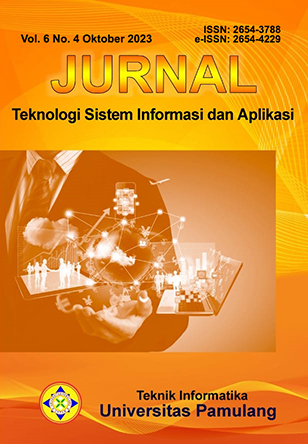Pemilihan Student of the month dengan Metode Simple Additive Weighting (SAW) dan Metode Weighted Product (WP) berbasis web
Keywords:
Sistem Pendukung Keputusan, SPK, student of the month, Simple Additive Weighting, SAW, Weighted Product, WP.Abstract
Every 1 (one) month SMK Nusantara 1 Tangerang City gives awards to its students. The award was given in the form of student of the month in order to increase the enthusiasm of learning students at SMK Nusantara 1 Tangerang City. The student of the month selection process is initiated by the principal with consideration from the vice principal and also the heads of expertise programs. However, until now the student of the month selection process still has a manual process that does not take into account the characteristics of the assessment criteria. Therefore, this study aims to evaluate the use of Simple Additive Weighting (SAW) method and Weighted Product (WP) method in the decision support system for the selection of student of the month. This research can help school principals in selecting student of the month more objectively. From this study obtained a final result of 0.994 for the SAW method and 0.050 for the WP method and stated that the student with the largest total score was Arminanda Khansa Sadiya.
References
Aldisa, R. T., Nugroho, F., Mesran, Sinaga, S. A., & Sussolaikah, K. (2022). Sistem Pendukung Keputusan Menentukan Siswa Terbaik Menggunakan Metode Simple Additive Weighting (SAW). Jurnal ELTIKOM, 2(1), 26–33. https://doi.org/10.31961/eltikom.v2i1.39
Anisa, D., Ningrum, W. S., Kusumo, R., & Putri, W. (2022). Sistem Pendukung Keputusan Penerimaan Beasiswa Menggunakan Metode Weighted Product. TIN: Terapan Informatika Nusantara, 2(8), 483–491. https://doi.org/10.47065/tin.v2i8.1064
Ginting, G., Mesran, & Manalu, Y. F. (2021). Penerapan Metode Simple Additive Weighting (SAW) dalam Pemberian Reward Bagi Pegawai Honorer Menggunakan Pembobotan Rank Order Centroid. Jurnal Media Informatika Budidarma, 5(4), 1667. https://doi.org/10.30865/mib.v5i4.3146
Handika, W., & Sholihin, M. . (2021). SISTEM PENDUKUNG KEPUTUSAN PENILAIAN KINERJA KARYAWAN MENGGUNAKAN METODE SIMPLE ADDITIVE WEIGHTING (SAW) (Studi Kasus : PT. Herman Brothers). 27, 1–10.
Harmayani, & Harahap, R. A. (2022). Perbandingan Metode WP dan SAW dalam Sistem Pendukung Keputusan untuk Menentukan Tingkat Keberhasilan Guru Mengajar di Tingkat SMK. Media Informatika Budidarma, 6(April), 923–932. https://doi.org/10.30865/mib.v6i2.3571
Kamdani, R., & Agustian, B. (2022). Perancangan Sitem Pendukung Keputusan Menggunakan Metode Saw ( Simple Additive Weighting ) Menentukan. Journal of Artificial Intelligence and Innovative Applications,
Lorenzia, B. A., & Zailani, A. U. (2022). Sistem Pendukung Keputusan Karyawan Terbaik Metode SAW dan WP Pada PT . Paramount Bed Indonesia. 1(07), 907–915.
Magdalena, M., & S, F. P. (2021). Implementasi Metode Weighted Product (WP) pada Sistem Pendukung Keputusan Pemberian Bonus Karyawan. JATISI (Jurnal Teknik Informatika Dan Sistem Informasi), 8(4), 2158–2170. https://doi.org/10.35957/jatisi.v8i4.1179
Mulyani, T. (2021). KOMPARASI METODE SAW (SIMPLE ADDITIVE WEIGHTING) DAN WP (WEIGHTED PRODUCT) DALAM SISTEM PENILIAN KINERJA KARYAWAN PADA PT BEONE OPTIMA SOLUSI (Vol. 7).
Pasaribu, S. A., & Darussalam, U. (2022). Komparasi Metode Simple Additive Weighting Dan Metode Weighted Product Web Based Untuk Menentukan Siswa Berprestasi. JIPI (Jurnal Ilmiah Penelitian Dan Pembelajaran Informatika), 7(1), 196–208. https://doi.org/10.29100/jipi.v7i1.2624
Rahayu, S., & Sindar, A. (2022). Sistem Pendukung Keputusan Penilaian Kinerja Guru Menggunakan Metode Simple Additive Weighting. Jurnal Ilmu Komputer Dan Informatika, 2(2), 103–112. https://doi.org/10.54082/jiki.28
Widyakunthaningrum, T., Yudhana, A., & Fadlil, A. (2022). SISTEM PENDUKUNG KEPUTUSAN UNTUK PENENTUAN KELAS UNGGULAN MENGGUNAKAN METODE WEIGHTED PRODUCT. 9(2), 200–206. https://doi.org/10.30656/jsii.v9i2.4224
Wijaya, I. K. A., Dantes, G. R., & Candiasa, I. M. (2021). Implementasi Sistem Pendukung Keputusan Pemilihan Guru dan Siswa Berprestasi dengan Kombinasi Metode Analytical Hierarchy Process dan Technique for Order Preference by Similarity to Ideal Solution. Jurnal Nasional Pendidikan Teknik Informatika (JANAPATI), 10(2), 77. https://doi.org/10.23887/janapati.v10i2.29386
Sahadi, S., Ardhiansyah, M., & Husain, T. (2020). Sistem Pendukung Keputusan Pemilihan Siswa/i Kelas Unggulan Menggunakan Metode AHP dan TOPSIS. Jurnal Teknologi Sistem Informasi, 1(2), 153–167. https://doi.org/10.35957/jtsi.v1i2.513
Downloads
Published
How to Cite
Issue
Section
License
Copyright (c) 2023 Muhammad Indra Rizaldi, Makhsun Makhsun, Achmad Hindasyah

This work is licensed under a Creative Commons Attribution-NonCommercial 4.0 International License.
Authors who publish with this journal agree to the following terms:
- Authors retain copyright and grant the journal right of first publication with the work simultaneously licensed under a Creative Commons Attribution License that allows others to share the work with an acknowledgement of the work's authorship and initial publication in this journal.
- Authors are able to enter into separate, additional contractual arrangements for the non-exclusive distribution of the journal's published version of the work (e.g., post it to an institutional repository or publish it in a book), with an acknowledgement of its initial publication in this journal.
- Authors are permitted and encouraged to post their work online (e.g., in institutional repositories or on their website) prior to and during the submission process, as it can lead to productive exchanges, as well as earlier and greater citation of published work (See The Effect of Open Access).
Jurnal Teknologi Sistem Informasi dan Aplikasi have CC BY-NC or an equivalent license as the optimal license for the publication, distribution, use, and reuse of scholarly work.
In developing strategy and setting priorities, Jurnal Teknologi Sistem Informasi dan Aplikasi recognize that free access is better than priced access, libre access is better than free access, and libre under CC BY-NC or the equivalent is better than libre under more restrictive open licenses. We should achieve what we can when we can. We should not delay achieving free in order to achieve libre, and we should not stop with free when we can achieve libre.
This work is licensed under a Creative Commons Attribution-NonCommercial 4.0 International (CC BY-NC 4.0) License
YOU ARE FREE TO:
- Share - copy and redistribute the material in any medium or format
- Adapt - remix, transform, and build upon the material for any purpose, even commercially.
- The licensor cannot revoke these freedoms as long as you follow the license terms



_2020_-_7(2)_2024_-_Thumbnail.png)












